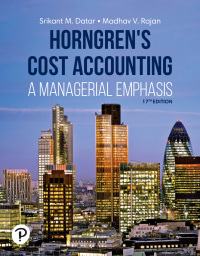Question
Not for nothing was Sophie Brazier, an acclaimed Michelin star chef. Coming from a family of culinary experts dating back three generations, it was Sophie's
Not for nothing was Sophie Brazier, an acclaimed Michelin star chef. Coming from a family of culinary experts dating back three generations, it was Sophie's great grandmother who was an inspiration behind her great grandfather becoming a famous chef during a time when women were hardly recognized in this profession. Sophie was not only a great chefbut also had the rare ability to share her knowledge and skills by training young budding cooks.
One fine spring morning, in April 2020, from her beautiful waterfront home in Montreal, when the world was crippled due to the COVID-19 pandemic, Sophie started to formalize her longtime dream of setting up a culinary institute to offer various courses to train and improve participants' culinary skills. She took some notes on the type of courses that she might be passionate about and in a moment of creative flourish, coined a name for the institute (Le Bleu Ecole de Cuisine) and also some names and descriptions for the cooking courses she wished to offer (Table 1). One of her broad strategic goals is to bring cooking to the corporate world and to the community. She wished to offer week-end courses to employees to learn healthy cooking, while also having fun. She also wished to offer a similar program for the young kids and community at large, which potentially could bring back the health and fun element to cooking. She deeply detested the fast food culture and held the view that it was singularly responsible for many modern-day malaises. Her mission was to bring the joy of delightful cooking and mindful eating back into everyone's lives.
Over the next couple of weeks, she held web-conferences with her tax accountant and shared broad details about the type of courses on offer, in terms of its duration, scheduling, and so on (Table 1). She also carried out extensive research to come up with an estimate of costs with the help of her tax accountant (Table 2). She realized that not all of these costs may be applicable for all courses that she intended to offer, however being unsure how to organize those costs and revenues to calculate profitability, she relied on her tax accountant. She did place a higher emphasis on Advertising/Marketing costs with a greater focus on Corporate clients and Community/Young weekend participants. She was also particular that cleaning and maintenance be carried out throughout the year to maintain good hygienic discipline. Since she wanted to make this affordable to most participants, she was keen to peg the fees at $399 per participant, as course fees. Thereon she commissioned her tax-accountant to estimate the profitability of the institute and if possible, individual courses.
Sophie's tax-accountant reverted in a week's time and reported a broad summary of operations and profitability (Table 4) and a cost per student (Table 3). In his calculations, although the individual courses looked profitable with a positive contribution margin, overall LBEC was projected to make a loss of C$ 152,260.00 in the first year of operations.This unnerved her no end.Despite the fact that Sophie was passionate about cooking and sharing her skills, she was not yet ready to make such a significant investment of her personal time and resources for a loss-making operation. Her conversations with the tax accountant was not enlightening or encouraging either. For example, she was not sure why the accountant combined many of the costs as common costs ($264,900) and not related it to the individual course groups. She also felt that the cost per student ($298) across all the courses, did not appear right. That is when she remembered her dearest high school friend, Sonu Mani, who herself went on to become a meritorious CPA graduate and now a senior partner with one of the Big 4 firms. She immediately got on phone with Sonu, who was enjoying a bit of respite amidst her radically changed schedule due to the COVID-19 pandemic. It was now left in Sonu's safe hands to save Sophie's worthy culinary institute!







Step by Step Solution
There are 3 Steps involved in it
Step: 1

Get Instant Access to Expert-Tailored Solutions
See step-by-step solutions with expert insights and AI powered tools for academic success
Step: 2

Step: 3

Ace Your Homework with AI
Get the answers you need in no time with our AI-driven, step-by-step assistance
Get Started


